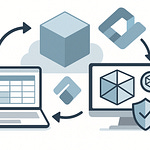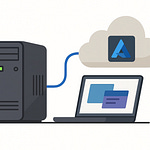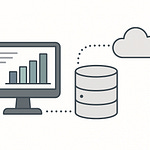Summary
Microsoft has a habit of renaming things in ways that make people scratch their heads — “Fabric,” “OneLake,” “Lakehouse,” “Warehouse,” etc. In this episode, I set out to cut through the naming noise and show what actually matters under the hood: how data storage, governance, and compute interact in Fabric, without assuming you’re an engineer.
We dig into how OneLake works as the foundation, what distinguishes a Warehouse from a Lakehouse, why Microsoft chose Delta + Parquet as the storage engine, and how shortcuts, governance, and workspace structure help (or hurt) your implementation. This isn’t marketing fluff — it’s the real architecture that determines whether your organization’s data projects succeed or collapse into chaos.
By the end, you’ll be thinking less “What is Fabric?” and more “How can we use Fabric smartly?” — with a sharper view of trade-offs, pitfalls, and strategies.
What You’ll Learn
The difference between Warehouse and Lakehouse in Microsoft Fabric
How OneLake acts as the underlying storage fabric for all data workloads
Why Delta + Parquet matter — not just as buzzwords, but as core guarantees (ACID, versioning, schema)
How shortcuts let you reuse data without duplication — and the governance risks involved
Best practices for workspace design, permissions, and governance layers
What to watch out for in real deployments (e.g. role mismatches, inconsistent access paths)
Full Transcript
Here’s a fun corporate trick: Microsoft managed to confuse half the industry by slapping the word “house” on anything with a data label. But here’s what you’ll actually get out of the next few minutes: we’ll nail down what OneLake really is, when to use a Warehouse versus a Lakehouse, and why Delta and Parquet keep your data from turning into a swamp of CSVs. That’s three concrete takeaways in plain English. Want the one‑page cheat sheet? Subscribe to the M365.Show newsletter.
Now, with the promise clear, let’s talk about Microsoft’s favorite game: naming roulette.
Lakehouse vs Warehouse: Microsoft’s Naming Roulette
When people first hear “Lakehouse” and “Warehouse,” it sounds like two flavors of the same thing. Same word ending, both live inside Fabric, so surely they’re interchangeable—except they’re not. The names are what trip teams up, because they hide the fact that these are different experiences built on the same storage foundation.
Here’s the plain breakdown. A Warehouse is SQL-first. It expects structured tables, defined schemas, and clean data. It’s what you point dashboards at, what your BI team lives in, and what delivers fast query responses without surprises. A Lakehouse, meanwhile, is the more flexible workbench. You can dump in JSON logs, broken CSVs, or Parquet files from another pipeline and not break the system. It’s designed for engineers and data scientists who run Spark notebooks, machine learning jobs, or messy transformations.
If you want a visual, skip the sitcom-length analogy: think of the Warehouse as a labeled pantry and the Lakehouse as a garage with the freezer tucked next to power tools. One is organized and efficient for everyday meals. The other has room for experiments, projects, and overflow. Both store food, but the vibe and workflow couldn’t be more different.
Now, here’s the important part Microsoft’s marketing can blur: neither exists in its own silo. Both Lakehouses and Warehouses in Fabric store their tables in the open Delta Parquet format, both sit on top of OneLake, and both give you consistent access to the underlying files. What’s different is the experience you interact with. Think of Fabric not as separate buildings, but as two different rooms built on the same concrete slab, each furnished for a specific kind of work.
From a user perspective, the divide is real. Analysts love Warehouses because they behave predictably with SQL and BI tools. They don’t want to crawl through raw web logs at 2 a.m.—they want structured tables with clean joins. Data engineers and scientists lean toward Lakehouses because they don’t want to spend weeks normalizing heaps of JSON just to answer “what’s trending in the logs.” They want Spark, Python, and flexibility.
So the decision pattern boils down to this: use a Warehouse when you need SQL-driven, curated reporting; use a Lakehouse when you’re working with semi-structured data, Spark, and exploration-heavy workloads. That single sentence separates successful projects from the ones where teams shout across Slack because no one knows why the “dashboard” keeps choking on raw log files.
And here’s the kicker—mixing up the two doesn’t just waste time, it creates political messes. If management assumes they’re interchangeable, analysts get saddled with raw exports they can’t process, while engineers waste hours building shadow tables that should’ve been Lakehouse assets from day one. The tools are designed to coexist, not to substitute for each other.
So the bottom line: Warehouses serve reporting. Lakehouses serve engineering and exploration. Same OneLake underneath, same Delta Parquet files, different optimizations. Get that distinction wrong, and your project drags. Get it right, and both sides of the data team stop fighting long enough to deliver something useful to the business.
And since this all hangs on the same shared layer, it raises the obvious question—what exactly is this OneLake that sits under everything?
OneLake: The Data Lake You Already Own
Picture this: you move into a new house, and surprise—there’s a giant underground pool already filled and ready to use. That’s what OneLake is in Fabric. You don’t install it, you don’t beg IT for storage accounts, and you definitely don’t file a ticket for provisioning. It’s automatically there. OneLake is created once per Fabric tenant, and every workspace, every Lakehouse, every Warehouse plugs into it by default. Under the hood, it actually runs on Azure Data Lake Storage Gen2, so it’s not some mystical new storage type—it’s Microsoft putting a SaaS layer on top of storage you probably already know.
Before OneLake, each department built its own “lake” because why not—storage accounts were cheap, and everyone believed their copy was the single source of truth. Marketing had one. Finance had one. Data science spun one up in another region “for performance.” The result was a swamp of duplicate files, rogue pipelines, and zero coordination. It was SharePoint sprawl, except this time the mistakes showed up in your Azure bill. Teams burned budget maintaining five lakes that didn’t talk to each other, and analysts wasted nights reconciling “final_v2” tables that never matched.
OneLake kills that off by default. Think of it as the single pool everyone has to share instead of each team digging muddy holes in their own backyards. Every object in Fabric—Lakehouses, Warehouses, Power BI datasets—lands in the same logical lake. That means no more excuses about Finance having its “own version” of the data. To make sharing easier, OneLake exposes a single file-system namespace that stretches across your entire tenant. Workspaces sit inside that namespace like folders, giving different groups their place to work without breaking discoverability. It even spans regions seamlessly, which is why shortcuts let you point at other sources without endless duplication. The small print: compute capacity is still regional and billed by assignment, so while your OneLake is global and logical, the engines you run on top of it are tied to regions and budgets.
At its core, OneLake standardizes storage around Delta Parquet files. Translation: instead of ten competing formats where every engine has to spin its own copy, Fabric speaks one language. SQL queries, Spark notebooks, machine learning jobs, Power BI dashboards—they all hit the same tabular store. Columnar layout makes queries faster, transactional support makes updates safe, and that reduces the nightmare of CSV scripts crisscrossing like spaghetti.
The structure is simple enough to explain to your boss in one diagram. At the very top you have your tenant—that’s the concrete slab the whole thing sits on. Inside the tenant are workspaces, like containers for departments, teams, or projects. Inside those workspaces live the actual data items: warehouses, lakehouses, datasets. It’s organized, predictable, and far less painful than juggling dozens of storage accounts and RBAC assignments across three regions. On top of this, Microsoft folds in governance as a default: Purview cataloging and sensitivity labeling are already wired in. That way, OneLake isn’t just raw storage, it also enforces discoverability, compliance, and policy from day one without you building it from scratch.
If you’ve lived the old way, the benefits are obvious. You stop paying to store the same table six different times. You stop debugging brittle pipelines that exist purely to sync finance copies with marketing copies. You stop getting those 3 a.m. calls where someone insists version FINAL_v3.xlsx is “the right one,” only to learn HR already published FINAL_v4. OneLake consolidates that pain into a single source of truth. No heroic intern consolidating files. No pipeline graveyard clogging budgets. Just one layer, one copy, and all the engines wired to it.
It’s not magic, though—it’s just pooled storage. And like any pool, if you don’t manage it, it can turn swampy real fast. OneLake gives you the centralized foundation, but it relies on the Delta format layer to keep data clean, consistent, and usable across different engines. That’s the real filter that turns OneLake into a lake worth swimming in.
And that brings us to the next piece of the puzzle—the unglamorous technology that keeps that water clear in the first place.
Delta and Parquet: The Unsexy Heroes
Ever heard someone drop “Delta Parquet” in a meeting and you just nodded along like you totally understood it? Happens to everyone. The truth is, it’s not a secret Microsoft code name or Star Trek tech—it’s just how Fabric stores tabular data under the hood. Every Lakehouse and Warehouse in Fabric writes to **Delta Parquet format**, which sounds dull until you realize it’s the reason your analytics don’t fall apart the second SQL and Spark meet in the same room.
Let’s start with Parquet. Parquet is a file format that stores data in columns instead of rows. That simple shift is a game-changer. Think of it this way: if your data is row-based, every query has to slog through every field in every record, even if all you asked for was “Customer_ID.” It’s like reading every Harry Potter book cover-to-cover just to count how many times “quidditch” shows up. Columnar storage flips that around—you only read the column you need. It’s like going straight to the dictionary index under “Q” and grabbing just the relevant bits.
That means queries run faster, fewer bytes are read, and your cloud bill doesn’t explode every time someone slices 200 million rows for a dashboard. Parquet delivers raw performance and efficiency. Without it, large tables turn into a laggy nightmare and cost far more than they should. With it, analysts can run their reports inside a coffee break instead of during an all-hands meeting.
But Parquet alone just gives us efficient files. What it doesn’t give us is control, reliability, or sanity when teams start hammering the same datasets. That’s where Delta Lake comes in. Delta wraps around those Parquet files and adds the boring grown-up stuff: **ACID transactions, schema enforcement, and table versioning.** These are the features that stop your data from splitting into five inconsistent versions the second multiple engines touch it.
In practical terms, Delta means every change is tracked, atomic, and consistent. If an update fails halfway, you don’t wake up to a half-broken table. Delta also gives “time-travel”—you can run queries as your table looked last week or last month. That’s huge when someone asks why numbers changed between two board decks. And on top of that, it comes with operational smarts: cleaning up stale files, compacting things so queries don’t degrade, and keeping performance tight over time.
What makes this combo special for Fabric is that both SQL engines and Spark engines can hit the exact same Delta Parquet table at the same time. No more cloning the sales dataset into three different places just because your SQL dev refused to touch Spark, and your data scientist refused to play with row blobs. Everyone talks to the same files, with consistency baked in. That’s the operational win: instead of data teams building silos out of paranoia, they can actually collaborate without trashing each other’s work.
Picture the alternative without Delta. SQL devs spin up their own warehouse export because raw lake files aren’t reliable. Data engineers create their own Spark-friendly copies, because SQL doesn’t play nice. Marketing grabs a CSV snapshot from last Tuesday and calls it official. Suddenly, the same dataset exists in three formats, with three slight variations, and the meeting turns into a blame game about why “Q2_sales” doesn’t add up. Delta kills that chaos by letting everyone work against the same single version of the truth.
From a business angle, this matters more than the acronyms. With Delta Parquet, you get **fewer duplicate copies, faster queries, and less hand‑wringing between SQL and Spark teams.** Analysts get their structured queries running fast. Data engineers update and transform on the fly without wrecking the schema. Leaders finally see consistent numbers without someone building Excel macros in the background to reconcile reports. Nobody publishes “final_FINAL_v2.xlsx” anymore, because that mess doesn’t exist in the first place.
And this is why a Fabric Lakehouse isn’t just a dumping ground of files. Thanks to Parquet’s efficiency and Delta’s reliability, it behaves much more like a proper database—fast, consistent, and trustworthy. That means you can query, collaborate, rewind to a prior state, and actually trust the answer. Not flashy, not glamorous—but it’s the foundation that keeps the whole system from collapsing under its own sprawl.
Of course, once your files start acting like clean tables, the next headache shows up: how do you avoid every team hauling around their own giant copy just to get access? Because nothing sabotages performance faster than three terabytes being shuffled back and forth like oversized email attachments.
Shortcuts: Sharing Without Duplicating (Finally)
Shortcuts are where Fabric finally earns its keep. Instead of multiplying datasets like rabbits, a shortcut just says, “That file lives over there—treat it like it’s here.” No extra copies, no bloated bills, no late-night reconciliation calls. It’s not flashy, but the payoff is immediate: one dataset, many references, lower costs, and a lot less arguing about which version is the “real” one.
Think of it this way: in the old world, every department made its own clone. Finance copied sales data into its workspace. Marketing copied the same thing again. Data science cloned it a third time just so Spark jobs wouldn’t crash. Five copies later, you’re paying five times the storage and holding weekly meetings to untangle which one was official. With shortcuts, that model is gone. You don’t move or replicate anything—you just plant a pointer. Suddenly, the dataset is visible where you need it, without chewing up your tenant’s footprint. No copies = lower storage bills and fewer reconciliation meetings.
The scope of these shortcuts is broader than most people realize. In Fabric, you can shortcut to data already in OneLake, across other workspaces, or even external sources like Azure Data Lake Storage Gen2, Amazon S3, and Dataverse. That list matters because no company’s data lives in just one clean lake. Someone always has history tucked away in S3, another group drops regulated records into Dataverse, and your engineers still have pet projects in ADLS. Instead of paying for consultants to build another batch pipeline, you drop a shortcut and Fabric treats the data like it’s local. This alone saves weeks of project time and a lot of angry eye rolls in steering meetings.
And here’s a pro tip: use shortcuts as a first step before migrating data. If your org isn’t ready to dump everything into Fabric on day one, shortcuts give you a bridge. Point to your existing S3 bucket or ADLS account, start analyzing in Fabric, and skip the frantic “rip and replace” pipeline rewrite. Later, if you want to consolidate into OneLake, fine. But shortcuts let you get business results today without blowing up your architecture.
That simplicity is also where the hidden governance traps live. Shortcut security isn’t uniform. If you hit data through Spark, the shortcut enforces the target’s underlying permissions—your identity gets checked directly. But if you query through SQL, it works differently: the engine defers to the shortcut creator’s identity, not every person running the query. Translation: if the person who built the SQL object had access, everyone else executing against it also gets through under their access. That can be brilliant when managed right—or a compliance nightmare if someone casually sets a shortcut to restricted payroll data. The fix is obvious but often overlooked: treat shortcut creators as de facto gatekeepers and audit who can publish them.
The cultural difference is huge. Before shortcuts, teams waved “official dataset” flags like medieval banners, except three other teams carried their own flags too. A sales report might exist in four versions, trimmed differently for execs, analysts, and engineers—none of which lined up. I’ve sat through calls where IT spent an entire weekend reconciling variances that didn’t exist in the source system, just in the copies. Shortcuts break that cycle. The dataset exists once. Everyone references it. Period. That’s it.
From an operational standpoint, shortcuts do two simple but critical things: they shrink your storage footprint and they stop pipeline sprawl. The “copy and paste” approach to data led to armies of half-broken ETL jobs humming along in forgotten integration accounts. Shortcuts strip away that overhead. One dataset, one upkeep, infinite re-use. Teams spend less time moving files and more time asking meaningful questions.
So the bottom line: shortcuts aren’t a toy feature—they’re the single biggest fix to the copy-and-paste madness of enterprise storage. They let you unify data across workspaces and clouds without rewriting everything, and done properly they make governance cleaner, not harder. One truth, many references.
But eliminating duplicate data only solves half the pain. Once everyone starts working against the same objects, the bigger risk becomes how they use them. Because nothing tanks collaboration faster than three teams marching into the same workspace and trampling each other’s files.
Workspaces and Governance: Keeping Teams From Tripping Over Each Other
If shortcuts stop the copy‑and‑paste madness, workspaces and governance are what stop chaos from creeping back in through the side door. This is the part where Fabric either stays clean or turns into the world’s most expensive junk drawer.
Here’s how Microsoft structured it. Think nesting dolls: at the very top you’ve got your tenant. That’s one per organization, and it’s where compliance boundaries live and the tenant admin holds the master keys. Inside that, you spin up workspaces. Each workspace is a box for a project or a department, with its own roster and rules. And inside those boxes sit the items you actually care about—lakehouses, warehouses, reports, notebooks. Tenant → workspace → items. The hierarchy is intentional; each layer hands down its rules to the layer beneath it.
Now, workspaces themselves come with four pre‑set roles, and it’s worth knowing them cold. Admins own everything—full control, add or remove people, reassign roles at will. Members can create and edit across the workspace. Contributors can make new items but don’t get to manage other people’s stuff. Viewers are strictly read‑only. That’s it: four roles, four levels of power. And for once Microsoft kept the names simple enough that your manager can follow along. Assign these roles carefully, and you’ll save yourself the joy of two VPs overwriting each other’s dashboards.
But you don’t stop there. Sometimes a person only needs to peek, not touch. That’s where item‑level permissions step in. These come in neat chunks: Read lets someone see the metadata and consume reports without touching source data. ReadData is for SQL—grants them query rights against tables through the SQL endpoint. And ReadAll? That’s full access for Spark; wide‑open table reads without SQL fuss. Hand out ReadAll only to your bona fide engineers, not to the intern who just learned what Spark is yesterday. Used correctly, item permissions decouple workspace membership from sensitive access and let you control exposure one artifact at a time.
Then there’s compute‑level security, which is where things get interesting. SQL endpoints give you fine‑grained controls like table filters and row‑level security. That’s how Finance sees just their regional slice while still pointing to the same warehouse. But here’s the catch: Spark doesn’t care about those SQL restrictions. Spark respects item‑level permissions like ReadAll, then loads the files from OneLake directly. Translation: if you need airtight row‑level governance, enforce it through the SQL routes. If you hand someone Spark ReadAll, they’re seeing everything, no matter how clever your SQL RLS setup is. So design your workflow with this split model in mind, or I promise you’ll field awkward questions in the audit.
What about organizing the workspaces themselves? Best practice is simple, but ignored everywhere. Either carve them by domain—the data mesh model—or by environment, like DEV, UAT, PROD. Both are proven patterns, and both reduce the mess. A domain‑driven mesh means Finance owns the finance workspace, Marketing owns theirs, and they share curated outputs instead of meddling inside each other’s data. An environment‑driven design works better if you’re a central BI team running production pipelines and need clean promotion paths. In either approach, protect shared consumption with item permissions and SQL row‑level security so consumers get what they need without rummaging through staging.
Skip this structure and you’ll get the nightmare. Multiple models of the “same truth,” duplicate shortcuts pointing to the same files with different names, and executives trading revenue numbers like baseball cards. I’ve cleaned that one up before—it takes longer than anyone wants to admit. Put the governance in day one, and suddenly Fabric feels like an enabler, not another battleground.
One last piece is discovery. Fabric ties into Purview so people can search across workspaces, spot existing datasets, and stop recreating them. Think of it as a catalog: boring, but life‑saving. Without it, every fresh analyst is hunting blind and duplicating data products just to get unstuck. With it, you get visibility, consistency, and fewer late‑night merges of “v2_final.”
That’s the payoff. Good governance means data mesh and hub‑and‑spoke both work in the same tenant. Executives, analysts, and engineers share durable products instead of clones. You get collaboration without handing away the keys to everything sensitive. It’s not flashy—it’s the lines on the road that keep the traffic flowing.
And once you see that, the picture of Fabric comes together. All the naming noise aside, the underlying parts—OneLake, Delta, shortcuts, and governance—actually solve real problems.
Conclusion
So here’s the blunt wrap-up: one pool, fewer copies, consistent reports, lower storage costs. IT stops firefighting duplicate datasets, analysts stop arguing with engineers, and leadership finally looks at numbers that line up without someone whispering, “don’t trust slide three.” That’s the actual payoff. A Forrester TEI study cited in industry materials even reported a 379% ROI over three years for organizations deploying Fabric. Translation: the fixes aren’t just cleaner—they’re cheaper.
Subscribe to the M365.Show newsletter at m365.show and leave a review—it’s basically the +5 buff that keeps this content rolling. Think of it as your XP contribution to the data guild.











